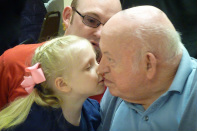 In my second of a series on camera gear, it is time to talk about my “big cameras.” There are some really large cameras out there, like the one shown here, which was created by George R. Lawrence in 1900. But for me, a “big camera” refers to a 35mm DSLR (Digital Single Lens Reflex). Since everything is relative, this size is compared to my point and shoot and smart phone camera. My introduction to the DSLR world was a Canon EOS Rebel XTi, also known as a 400D. Just as a side bar, I have never understood the Canon numbering system. You would think that the bigger the number, the larger and more sophisticated the camera. But that is not the case - the XTi (400D) is Canon’s entry level DSLR, a relatively low-priced, light-weight, crop-sensor digital camera with a fairly simple to use dial for the manual and semi-manual modes. For the first four years, I used the fully automatic mode for 99% of my shots. I probably experimented with Aperture Priority mode a few times, but it was mostly the little green square of the Auto Mode that caught my fancy. I had no idea about f-stops or the relation between aperture, shutter speed and ISO. I really didn’t care; I was just happy to have pictures that came out looking relatively decent, and I was happy to have the camera figure that out for me. Then my local high school had a class in photography, just enough to whet my appetite. Before I knew it, I was hooked, and started taking classes at the local community college, COD (College of DuPage). The instructors wanted us to shoot in manual mode, so I learned how to do that. They wanted us to shoot in RAW format, so I switched from JPEG to JPEG+RAW and finally to RAW, with a few glitches encountered along the way. I discovered that I liked having full control over all those combinations that had so mystified me before. The XTi is relatively easy to use, and so it became second nature to spin the dial to get the right shutter speed or push in what I call the ‘alt’ button and spin the dial to change the aperture setting. I learned how to blur the background, otherwise known as shallow depth of field. I figured out how to take group shots and include myself in them. I learned how to selectively focus, and how to use many other features and techniques to achieve the exact effect I was looking for. Even after several years with my XTi, I am still learning new things about it, still going back to my dog-eared manual to see what other capabilities it has. After six years with this camera, there are many settings that I have never used and may never use; and there are some features and instructions that still mystify me. So, my DSLR is my camera of choice for “serious” work, for my personal projects, for class work, for images I exhibit and hope to sell. The point and shoot and cellphone cameras are for everyday and documentary shots that may live their life on my computer, or may find their way to social media, newsletters, and other means of sharing captured experiences with friends. For comparison purposes, the XTi is a 10 megapixel camera. Actual file sizes vary, but my RAW images normally range between 8 and 9 MB, and are in a 3:2 aspect ratio, with dimensions of 3888 x 2592 pixels. I am happy with the print quality for both 8x10 and 11x14 inch prints. On a couple of occasions, I have made large-sized canvas prints, and been happy with the results. The Lumix DMC-ZS3 is a 10 megapixel point-and-shoot camera that can take images in either a 3:2 or 4:3 aspect ratio. I use the 4:3 aspect ratio, and the JPEG file sizes are generally between 3 and 5MB, with dimensions of 3684 x 2736 pixels. The camera on the iPhone 4S is an 8 megapixel camera. I have printed exhibition quality images as large as 11x14 inches. Most of my iPhone and point-and-shoot images are used for sharing and social media, and are quite suitable for internet use as well as print in newsletters. Next time: limitations of the XTi, and moving up to the next level.
0 Comments
 Flowers from the French Market Have you ever been told that you have really nice photographic images, followed by the dreaded comment “you must have a really nice camera?” Or worse yet, admired another photographer’s work and thought “if I only had a nice camera like he/she must have.” Perhaps you have admired those photographers whose websites list all the camera gear that they used in a particular photo shoot, or maybe there was some envy involved, or just a feeling of being turned off. Those are just a few examples of why camera gear really isn’t all that important. Some of the greatest images have been made with a home-made pinhole camera, or a smart phone, or without a camera or lens of any sort at all. There is so much more to creating great images than spinning a few dials and clicking the shutter button. So why IS camera gear important? To illustrate, let me say that my own camera collection includes both film and digital cameras, point-and-shoots, and SLRs. Some of them spend most of the time in the drawer or closet, and others are with me or close at hand all the time. I seem to have compartmentalized what cameras I use for which purposes. This blog-post deals with the informal, every-day snapshots and the camera gear I use most often for those. Later on, I will continue this thread with my “big” cameras. My iPhone (which has 2 cameras), and point-and-shoot are always with me - either in a pocket, purse, or on my belt. These are my “walking around” cameras, my security blanket in case I see something great that I need/want to capture. Their main advantage is small size and unobtrusiveness. The images are mostly documentary - I was at a Lions Club meeting or American Legion event, or with a friend or family member, or in the forest preserve walking the dogs. You get the idea. The relatively small image size and file type (jpeg) are suitable for sharing on social media and via e-mail, as well as useful for creating collage-type display boards. They are great publicity for the Lions Clubs, and appear frequently in Club, District, and State newsletters and magazines. The iPhone photos are particularly well-suited for sharing on the Roselle Lions Facebook page https://www.facebook.com/RoselleLionsClub and website http://www.e-clubhouse.org/sites/roselle/index.php. So, my everyday camera gear is light-weight, easy to carry around, and most suitable for snapshots of everyday life. Digital technology for the point-and-shoots and smart-camera phones has come a long way since they first appeared on the scene. They are not my only camera gear, but they are a very important part of my life as a photographer.  This blog post is dedicated to Gil Moberg, a long-time member of the Roselle Lions and the Roselle American Legion. He was also the dear father of Jerri Anne Struckmeyer and her sister Dianne Seward. As we approach Fathers’ Day, I am reminded of the importance of sharing photos. Let me just say that I am one of the worst in this category - in the “old” film days, I often had images sitting in the camera for six months to a year, sometimes longer, before I took the roll to the corner drugstore for developing. It was not uncommon to see photos in July of a prior Christmas family gathering. Now with the digital era, there is no excuse for such procrastination. It is easier to share images, especially with e-mail, social media like Facebook; and photo sharing sites like Flickr, Picasa and a host of others. But, you still have to get the photos out of the digital device and into the eyes and hands of friends and family. To illustrate the importance of sharing, last year I attended the Mothers’ Day Brunch held by the Roselle American Legion Auxiliary. As usual, I had my point-and-shoot with me, so I just started taking photos of the attendees. By now, the Legion Family is used to me and my cameras, and eventually I do share the images on a display board at the Legion Hall, so people are always willing and eager to pose or be captured in candid moments. My good friend Jerri Anne was there with her Stepfather Gil, his grandson Jonathan and wife Amanda and their children Madeline and Lillian; all of whom had come from out of town for a special Mothers’ Day gathering. Jerri asked if I would take a photo of the group, and later I printed and sent her a few of “the best.” They were not studio quality, not the greatest photos in the world. They were basically snapshots for the family album. But it was an important gathering and a tender moment. That is what made the photos so special. As it turns out, that would be the last Mothers’ Day gathering for the family. Sadly, Gil passed away last December. When Jerri called to give me the news, and ask if I had any photos of Gil for the Memorial Service, I was pleased and honored to send the digital copies over to the funeral home. Somehow it is easier to talk about the passing of someone else’s father, and the story of Gil is still fresh in memory. My own father, Bruce Walthers passed away in 2007, and my father-in-law John C Barsanti passed away in 1989. I will be thinking of both of them on this coming Fathers’ Day. As you celebrate with your families and fathers, get out your digital devices and take a few photos of them. Whether it is with a point-and-shoot, an SLR, or a cellphone; take those photos. Process them, print them, share them. |
Archives
July 2020
|

 RSS Feed
RSS Feed